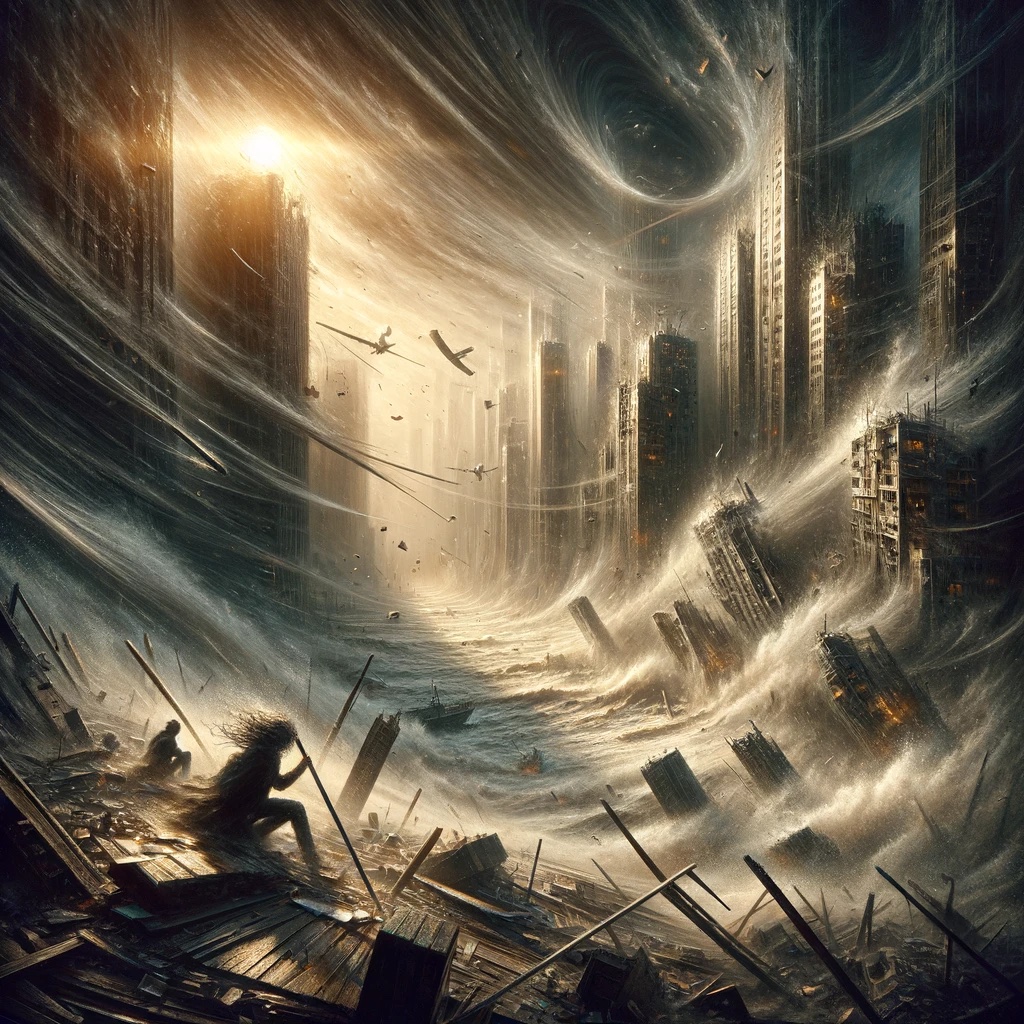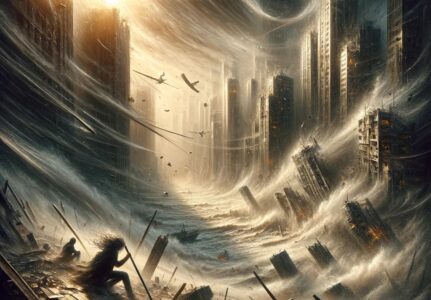Unveiling the Dystopian World of J.G. Ballard
In the realm of science fiction, certain authors stand out as visionary pioneers, creators of worlds that challenge our perceptions of reality and humanity. One such luminary is J.G. Ballard, a writer known for his exploration of the human psyche under the influence of extreme environments. Among his early works, “The Wind from Nowhere” stands as a haunting testament to his literary prowess. In this article, we’ll delve into the depths of this novel, examining its plot, key characters, central themes, inspiration, reviews, cultural impact, and offering suggestions for similar books by the same author.
The Plot Unveiled
“The Wind from Nowhere” takes readers on a journey through a world in the throes of environmental catastrophe. Ballard paints a bleak picture of a future where humanity is forced to confront the relentless and escalating force of nature itself: the wind. The novel begins with a breeze so gentle that it’s hardly noticeable. However, this is merely the calm before the storm.
As the story unfolds, the wind intensifies, becoming a tempest of unimaginable power. The relentless gales reshape the world, transforming once-thriving cities into desolate wastelands. Civilization crumbles under the onslaught of this unstoppable force, and society is thrown into chaos. Against this backdrop, Ballard weaves the narratives of various characters who must grapple with the existential crisis brought on by the wind.
Key Characters
Ballard’s characters are intricately woven into the fabric of his dystopian world, each representing a facet of human nature in the face of impending doom.
- Doctor Charles Ransom: A meteorologist and the novel’s protagonist, Ransom is dedicated to understanding the origins and nature of the wind. His journey becomes both a scientific exploration and a personal quest for survival.
- Fran Baring: Ransom’s love interest and fellow survivor, Fran provides a human touch to the story, as her relationship with Ransom evolves amidst the chaos.
- Hardoon: A ruthless businessman who capitalizes on the wind’s devastation, Hardoon symbolizes the darker aspects of human ambition in the face of disaster.
- The Governor: A once-powerful figure, the Governor is reduced to a symbol of impotence as the wind sweeps away the trappings of authority.
- Gustavus Adolphus: A mysterious figure who embodies the enigmatic nature of the wind, Gustavus Adolphus adds an element of intrigue and mysticism to the narrative.
Key Themes
“The Wind from Nowhere” explores a multitude of themes, many of which are hallmarks of Ballard’s oeuvre:
- Apocalypse and Survival: The novel delves into the apocalypse genre, examining how individuals and society as a whole respond when faced with imminent destruction. Survival, both physical and psychological, is a central concern.
- Environmental Catastrophe: Ballard’s prescient exploration of environmental disaster serves as a warning of the consequences of humanity’s impact on the natural world. The wind, as a destructive force, can be seen as a metaphor for climate change.
- Human Nature: The novel dissects human behavior under extreme circumstances, revealing the best and worst aspects of our species. It questions whether our innate nature can be altered or if we are ultimately slaves to our primal instincts.
- The Fragility of Civilization: Ballard highlights the precarious nature of human civilization, suggesting that beneath the veneer of progress, there lurks vulnerability. The wind exposes the fragility of societal structures and norms.
- Isolation and Desolation: As the wind isolates characters and erases the familiar landscapes of their lives, it prompts them to confront their own isolation and the desolation that exists within themselves.
What Inspired the Book
To understand the genesis of “The Wind from Nowhere,” one must delve into J.G. Ballard’s life and influences. Ballard, who was born in 1930 in Shanghai, China, experienced the horrors of World War II as a child. His family was interned in a Japanese prison camp, an experience that left an indelible mark on his psyche. This trauma and his subsequent life in post-war England shaped his worldview and his writing.
Ballard was also influenced by the burgeoning environmental awareness of the 1960s. This era saw the beginnings of the modern environmental movement and a growing concern about the impact of human activity on the planet. “The Wind from Nowhere” can be seen as a response to this environmental awakening, a cautionary tale about the consequences of ecological negligence.
Additionally, Ballard’s fascination with psychology and the human mind is evident in the novel. His interest in how individuals respond to extreme circumstances and the disintegration of society is a recurring theme in his work, one that he would explore further in novels like “High-Rise” and “Empire of the Sun.”
Reviews and Cultural Impact
Upon its release in 1961, “The Wind from Nowhere” garnered attention and critical acclaim. Ballard’s unique blend of science fiction and psychological exploration captivated readers and critics alike. The novel was praised for its haunting portrayal of a world in chaos and the depth of its character development.
One of the novel’s most enduring impacts is its contribution to the genre of climate fiction, or cli-fi. Long before climate change became a mainstream concern, Ballard was addressing environmental catastrophe in his work. “The Wind from Nowhere” can be viewed as a precursor to the modern cli-fi movement, influencing later authors who explored the intersection of environmental issues and speculative fiction.
Examples of Similar Books
If you found “The Wind from Nowhere” intriguing and are eager for more of J.G. Ballard’s distinctive style, there are several other works by the author that you should explore:
- “The Drowned World” (1962): This novel, set in a post-apocalyptic future where rising sea levels have inundated the planet, further delves into Ballard’s fascination with environmental catastrophe and its psychological effects on characters.
- “High-Rise” (1975): A chilling exploration of the breakdown of societal order within the confines of a luxury apartment building, “High-Rise” delves into the dark recesses of human nature when confronted with isolation and chaos.
- “Empire of the Sun” (1984): A departure from his science fiction works, this semi-autobiographical novel draws from Ballard’s own experiences as a child in a Japanese internment camp during World War II. It offers a poignant and harrowing glimpse into the human spirit’s resilience in the face of adversity.
- “Crash” (1973): A controversial and provocative work, “Crash” delves into the disturbing realm of car crash fetishism and the eroticization of violence. It’s a stark departure from his earlier science fiction, delving into the darker corners of human desire
Move Cli-Fi novels
Climate apocalypse novels, often categorized as “cli-fi,” have gained prominence in recent years as the climate crisis has become a pressing global issue. Here are some notable examples:
- “The Water Knife” by Paolo Bacigalupi (2015) – Set in a future where water scarcity has led to brutal conflicts in the American Southwest, this novel explores the consequences of a drying world and the lengths people will go to secure water resources.
- “The Road” by Cormac McCarthy (2006) – While not explicitly about climate change, this post-apocalyptic tale paints a bleak picture of a world devastated by environmental collapse, where a father and son struggle to survive in a barren, ash-covered landscape.
- “Parable of the Sower” by Octavia E. Butler (1993) – In a world plagued by climate change and societal breakdown, a young woman with a unique ability sets out on a journey to create a new religion based on empathy and sustainability.
- “The Windup Girl” by Paolo Bacigalupi (2009) – Bacigalupi returns with a vision of a world powered by biotechnology. This novel explores the consequences of genetic engineering and the impact of climate change on agriculture and economies.
- “Oryx and Crake” by Margaret Atwood (2003) – The first book in Atwood’s MaddAddam trilogy, this novel imagines a world where corporate greed, genetic engineering, and environmental degradation have led to a devastating pandemic.
- “The Children of Men” by P.D. James (1992) – In a world where humanity faces infertility and the impending extinction of the species, this novel explores themes of despair, hope, and the consequences of environmental decline.
- “The Year of the Flood” by Margaret Atwood (2009) – The second book in the MaddAddam trilogy, this story runs parallel to “Oryx and Crake,” delving further into the ecological and societal consequences of corporate-driven environmental collapse.
- “New York 2140” by Kim Stanley Robinson (2017) – Set in a future New York City partially submerged due to rising sea levels, this novel explores the lives of residents in a transformed urban landscape and the resilience of the human spirit.
- “The Sixth Extinction: An Unnatural History” by Elizabeth Kolbert (2014) – While not a work of fiction, this Pulitzer Prize-winning book delves into the ongoing mass extinction event caused by human activities, highlighting the urgency of addressing climate change.
These novels offer a diverse range of perspectives on climate-related apocalypse, from the near-future scenarios to far-reaching visions of environmental devastation. They reflect our growing awareness of the environmental challenges we face and the need to address them.
Other Books by the Same Author
J.G. Ballard’s literary career spans several decades, and he has left an indelible mark on the world of science fiction and speculative fiction. Here are some of his other notable works:
- “Concrete Island” (1974): This novel follows the journey of a man stranded on a traffic island amidst a sea of highways, exploring themes of isolation and urban alienation.
- “The Crystal World” (1966): Set in a jungle where everything is turning to crystal, this novel blends science fiction with surrealism, creating a dreamlike and mesmerizing narrative.
- “The Atrocity Exhibition” (1970): A collection of experimental short stories, this work delves into the fractured psyche of modern society, offering a disorienting but thought-provoking reading experience.
- “Cocaine Nights” (1996): In this novel, Ballard explores themes of hedonism and moral decay within an affluent resort community, leading to a disturbing investigation.
J.G. Ballard’s body of work is a testament to his willingness to push the boundaries of conventional storytelling. His novels challenge readers to confront the darkest aspects of human nature and society, making him a seminal figure in the world of speculative fiction.
The Wind from Nowhere
As we look back at “The Wind from Nowhere,” we see a novel that not only captivates with its apocalyptic vision but also serves as a warning about the fragile balance between human civilization and the natural world. Ballard’s prescience in addressing environmental concerns, as well as his exploration of the human psyche, cements his place as a visionary author whose works continue to resonate with readers today.
- J.G. Ballard – Official Website – Explore the official website dedicated to J.G. Ballard, where you can find information about his life, works, and legacy.
- Goodreads – The Wind from Nowhere – Check out reader reviews, ratings, and discussions about “The Wind from Nowhere” on Goodreads.
- Cli-Fi: Exploring Climate Change in Literature – Learn more about the genre of climate fiction (cli-fi) and its relevance to “The Wind from Nowhere.”


